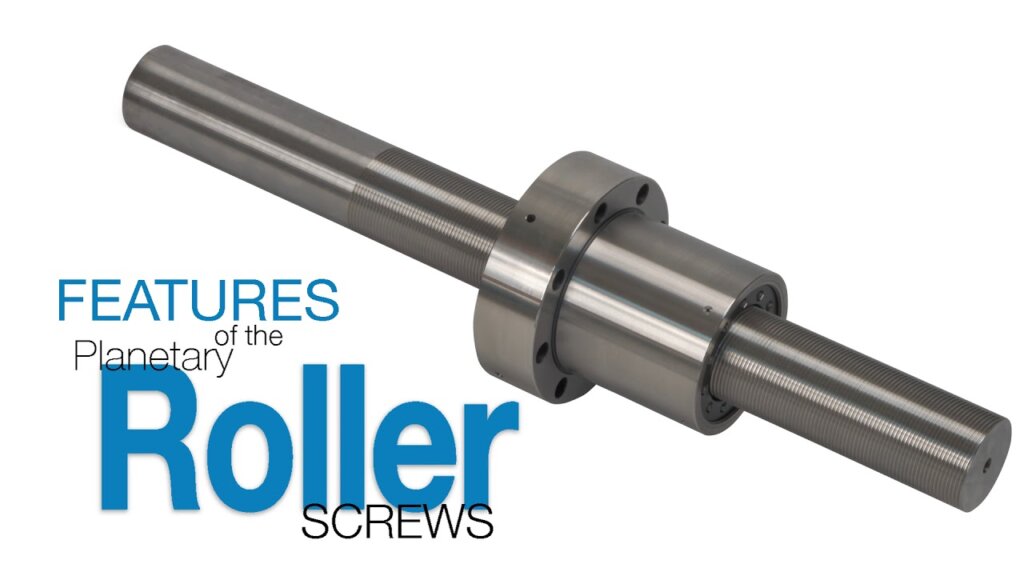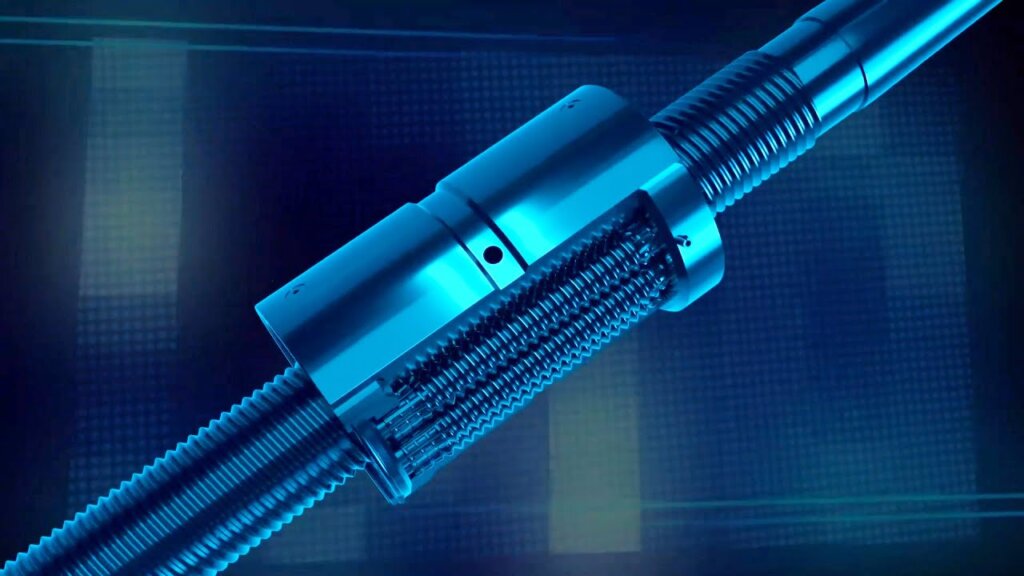Page Navigation
Long Lasting, High Precision, Low Maintenance
When you work with Tolomatic for roller screw linear actuators — with electric, high force, heavy duty, ball screw, hygienic and other options available — you’re guaranteed help selecting the optimal screw technology for your specific application. We don’t take a “one technology” approach to customer needs — we help provide industry-best sizing, selection, quality and application advice backed by reliable aftermarket service.
You can start your learning journey now with educational materials:
- Selecting the Optimal Screw Technology
- A Resource on Electric Linear Actuators: What a machine builder needs to know
Otherwise, you can jump straight to browsing specific products or contacting our team to get specific questions answered.
Download the Roller Screw Brochure
Explore Key Features of Planetary Roller Screws
Explore Unique Advantages of Roller Screws
Watch Planetary Roller Screws in Action
Anatomy of a Planetary (Standard) Roller Screw
Planetary roller screws (also called standard roller screws) have precision-ground threads that match multiple precision-ground rollers in the nut. These rolling elements transmit force very efficiently. Roller screw components provide more points of contact allowing for higher force capability and longer life.
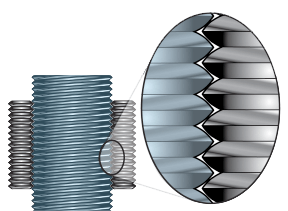
Using a linear actuator with roller screw technology allows engineers to reach new levels of control, performance, and efficiency in applications that were previously dominated by hydraulic cylinders.
Tolomatic manufacturers standard roller screws for its actuators. These screws are case (surface) hardened before precision grinding, resulting in very deep case hardness and high Dynamic Load Rating (DLR*).

How do you select the correct screw for heavy duty, high force linear actuator applications?
There are several screw technology options to consider when specifying high force electric linear actuators – standard planetary roller screws, inverted roller screws and ball screws. Each technology has its advantages and disadvantages when compared to one another.

To select the best option, it is critical to let the application specifications be the guide. Some companies only sell ball screw linear actuators — electric, heavy duty or otherwise — and some companies only sell roller screw linear actuators. Take caution when evaluating “there is only one technology” type vendors. Every application is different and both technologies have their unique strengths.
Tolomatic manufactures both roller screw and ball screw high force electric linear actuators. Tolomatic’s online electric actuator sizing software guides engineers through application specifications including force, speed, dwells, life estimates and other factors in order to make the correct choice.
What’s the difference between ball and roller screws (inverted and planetary)?
Standard Planetary roller screws offer the highest dynamic load rating for the longest life of the three technologies. Additionally:
- Both roller screw technologies are good choices for repeated stress applications (pressing, inserting, riveting) in the same area of actuator stroke.
- Roller screws have a significant increase in contact area which allows for longer life and higher forces exerted in the same package size compared to ball screws. However, this increased contact area also creates more heat with the same amount of work.
- Ball screws, because they have less contact points, are a little more efficient in heat management than roller screws which allows them to operate cooler in high duty cycle and high speed applications.
- Heat management is a major factor in how well lubricants hold up over time and whether the actuator or screw can last as long as expected.
For a more visual understanding of these comparisons, you can review the table below.
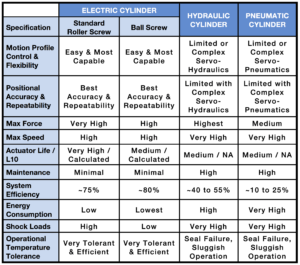
How do inverted roller screw linear actuators work?
An inverted roller screw operates much the same as a standard roller screw except the functions of the nut and screw are reversed so the rollers move inside the nut.
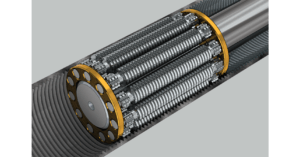
Most inverted roller screws used in linear actuators are produced using a process other than grinding to inexpensively create threads inside the nut. The hardening process is performed after the nut is machined and results in a much shallower case hardness depth and softer threads than those of standard roller screws. This leads to a significantly lower DLR* (lower life) and more challenges with maintaining lubrication.
Standard Planetary Roller Screw vs. Inverted Roller Screw

This chart reflects integrated servo actuators with standard and inverted screw designs. The DLRs listed here are selected from like-sized product.
By utilizing the inverted design in an actuator, the actuator may be a little more compact than an actuator with a standard roller screw, but this comes at a sacrifice of lower DLR (lower life).
Because of this, Tolomatic only supplies linear actuators with standard planetary roller screws to maximize service life.
How do ball screw linear actuators work?
Ball screws get their name from the recirculating ball bearings that fit between arch-shaped screw threads and corresponding threads in the nut. The ball bearings transmit force and relative motion efficiently as they roll through one or more circuits in the nut.

Electric ball screw linear actuators have higher heavy duty thrust capabilities, longer service lives and higher efficiency than those with acme screw systems, but they can’t match the performance of roller screw actuators.
Ball screw actuators can be back-driven and noisy. They’re ideal for applications that require high duty cycles, moderately high thrust and moderate speeds and tend to be reasonably priced, making them popular in many applications. When it comes to comparing roller screw vs ball screw of similar size and lead, a ball screw’s ball bearings have fewer points of contact than roller screws as shown in the diagram below.
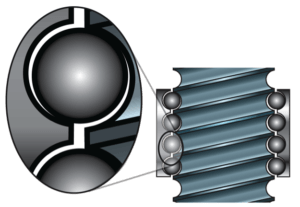
This, plus a design that allows the bearings to contact each other, limits the ball screw’s DLR*, leading to lower forces and shorter life.

For most applications that require high force, repetitive cycles and long expected life, Tolomatic will recommend a roller screw linear actuator. However, if the force is lower and high continuous speeds are present in the application, Tolomatic may recommend a ball screw actuator.
Take a Closer Look at Tolomatic Roller Screw Linear Actuators
Tolomatic offers a range of high-force electric linear actuators, all with long-lasting standard planetary roller screws
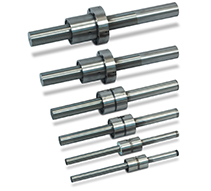
Roller Screws
Verified and tested extensively
Proven long, reliable life
Configurable stroke lengths
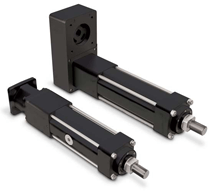
RSX Extreme Force Electric Rod Actuators
Roller screw driven
Forces up to 40,000 lbf (178 kN)
Flexible motor mounts

RSA-HT Heavy Duty Electric Rod Actuators
Add any servo motor
Forces up to 13,039 lbf (58 kN)
Economical ball screw options

ServoWeld® Resistance Spot Welding Actuators
Multiple designs for various weld guns
20+ million welds
Superior welds & force repeatability
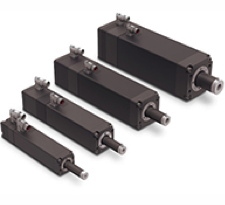
IMA Integrated Servo Motor Actuators
Integrated servo motor design
Forces up to 6,875 (30.6 kN)
Compatible with many servo drives
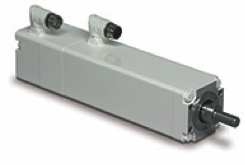
IMA Food Grade Linear Actuators
Food Grade white epoxy coating
Forces up to 6,875 lbs (30.6 kN)
IP67 rating
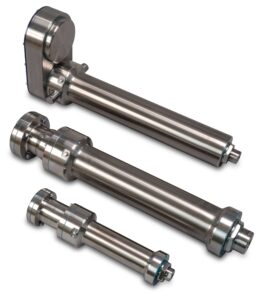
RSH Hygienic Electric Rod Style Actuators
316 Stainless Steel Construction
Forces up to 7,943 lbf (35.3 kN)
IP69k, clean-in-place


